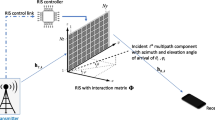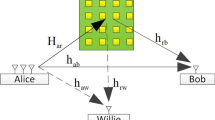Abstract
Intelligent reflecting surface (IRS) has emerged as a viable technology to enhance the spectral efficiency of wireless communication systems by intelligently controlling wireless signal propagation. In wireless communication governed by the IRS, the acquisition of channel state information (CSI) is essential for designing the optimal beamforming. However, acquiring the CSI is difficult as the IRS does not have radio frequency chains to transmit/receive signals and the capability to process the signals is also limited. The cascaded channel linking the base station (BS) and a user through the IRS does not necessarily adhere to a specific channel distribution. Conventional and deep learning-based techniques for channel estimation face challenges: the pilot overhead and compromised estimation accuracy due to assumptions of prior channel distribution and noisy signal. To overcome these issues a novel generative cascaded channel estimation (GCCE) model based on a generative adversarial network (GAN) is proposed to estimate the cascaded channel. The GGCE model reduces the reliance on pilot signals, effectively minimizing pilot overhead, by deriving CSI from received signal data. To enhance the estimation accuracy, the channel correlation information is provided as a conditioning factor for the GCCE model. Additionally, a denoising network is integrated into the GCCE framework to effectively remove noise from the received signal. These integrations collectively enhance the estimation accuracy of the GCCE model compared to the initial GAN setup. Experimental results illustrate the superiority of the proposed GCCE model over conventional and deep learning techniques when provided with the same pilot count.











Similar content being viewed by others
References
Shaikh, F. S., & Wismüller, R. (2018). Routing in multi-hop cellular device-to-device (D2D) networks: A survey. IEEE Communications Surveys and Tutorials, 20(4), 2622–2657.
Mustafa, H. A. U., Imran, M. A., Shakir, M. Z., Imran, A., & Tafazolli, R. (2016). Separation framework: An enabler for cooperative and d2d communication for future 5g networks. IEEE Communications Surveys and Tutorials, 18(1), 419–445. https://doi.org/10.1109/COMST.2015.2459596
Singh, S., Trivedi, A., & Saxena, D. (2023). Unsupervised LoS/NLoS identification in mmwave communication using two-stage machine learning framework. Physical Communication, 59, 102118.
Hu, S., Rusek, F., & Edfors, O. (2018). Beyond massive mimo: The potential of data transmission with large intelligent surfaces. IEEE Transactions on Signal Processing, 66(10), 2746–2758.
Wu, Q., & Zhang, R. (2019). Intelligent reflecting surface enhanced wireless network via joint active and passive beamforming. IEEE Transactions on Wireless Communications, 18(11), 5394–5409.
Yu, G., Chen, X., Zhong, C., Ng, D. W. K., & Zhang, Z. (2020). Design, analysis, and optimization of a large intelligent reflecting surface-aided B5G cellular internet of things. IEEE Internet of Things Journal, 7(9), 8902–8916.
Li, G.-H., Yue, D.-W., & Qi, F. (2022). Joint beamforming and power allocation for intelligent reflecting surface-aided millimeter wave MIMO systems. Wireless Networks, 28(5), 1935–1947.
Huang, C., Zappone, A., Debbah, M., & Yuen, C. (2018) Achievable rate maximization by passive intelligent mirrors. In: 2018 IEEE International Conference on Acoustics, Speech and Signal Processing (ICASSP), pp. 3714–3718 . IEEE
Mishra, D., & Johansson, H. (2019). Channel estimation and low-complexity beamforming design for passive intelligent surface assisted MISO wireless energy transfer. In: ICASSP 2019-2019 IEEE International Conference on Acoustics, Speech and Signal Processing (ICASSP), pp. 4659–4663. IEEE
Jensen, T.L., & De Carvalho, E. (2020). An optimal channel estimation scheme for intelligent reflecting surfaces based on a minimum variance unbiased estimator. In: ICASSP 2020-2020 IEEE International Conference on Acoustics, Speech and Signal Processing (ICASSP), pp. 5000–5004. IEEE
Wang, Z., Liu, L., & Cui, S. (2020). Channel estimation for intelligent reflecting surface assisted multiuser communications: Framework, algorithms, and analysis. IEEE Transactions on Wireless Communications, 19(10), 6607–6620. https://doi.org/10.1109/TWC.2020.3004330
Wang, P., Fang, J., Duan, H., & Li, H. (2020). Compressed channel estimation for intelligent reflecting surface-assisted millimeter wave systems. IEEE Signal Processing Letters, 27, 905–909.
You, Y., Zhang, L., Yang, M., Huang, Y., You, X., & Zhang, C. (2022). Structured OMP for irs-assisted Mmwave channel estimation by exploiting angular spread. IEEE Transactions on Vehicular Technology, 71(4), 4444–4448.
Wang, P., Fang, J., Duan, H., & Li, H. (2020). Compressed channel estimation for intelligent reflecting surface-assisted millimeter wave systems. IEEE Signal Processing Letters, 27, 905–909. https://doi.org/10.1109/LSP.2020.2998357
Guan, X., Wu, Q., & Zhang, R. (2021). Anchor-assisted channel estimation for intelligent reflecting surface aided multiuser communication. IEEE Transactions on Wireless Communications
Ruan, C., Zhang, Z., Jiang, H., Dang, J., Wu, L., & Zhang, H. (2022). Approximate message passing for channel estimation in reconfigurable intelligent surface aided MIMO multiuser systems. IEEE Transactions on Communications, 70(8), 5469–5481. https://doi.org/10.1109/TCOMM.2022.3182369
Wang, Y., Lu, H., & Sun, H. (2021). Channel estimation in irs-enhanced mmwave system with super-resolution network. IEEE Communications Letters, 25(8), 2599–2603. https://doi.org/10.1109/LCOMM.2021.3079322
Liu, C., Liu, X., Ng, D. W. K., & Yuan, J. (2022). Deep residual learning for channel estimation in intelligent reflecting surface-assisted multi-user communications. IEEE Transactions on Wireless Communications, 21(2), 898–912. https://doi.org/10.1109/TWC.2021.3100148
Dong, Y., Wang, H., & Yao, Y.-D. (2020). Channel estimation for one-bit multiuser massive MIMO using conditional GAN. IEEE Communications Letters, 25(3), 854–858.
Ye, M., Zhang, H., & Wang, J.-B. (2022). Channel estimation for intelligent reflecting surface aided wireless communications using conditional gan. IEEE Communications Letters, 26(10), 2340–2344. https://doi.org/10.1109/LCOMM.2022.3169213
Prasanna, D., & Murthy, C. R. (2021). Mmwave channel estimation via compressive covariance estimation: Role of sparsity and intra-vector correlation. IEEE Transactions on Signal Processing, 69, 2356–2370.
Goodfellow, I., Pouget-Abadie, J., Mirza, M., Xu, B., Warde-Farley, D., Ozair, S., Courville, A., Bengio, Y., Ghahramani, Z., Welling, M., et al. (2014). Generative adversarial nets. Advances in Neural Information Processing Systems, 27.
Radford, A., Metz, L., & Chintala, S. (2015). Unsupervised representation learning with deep convolutional generative adversarial networks. arXiv:1511.06434
Zhang, K., Zuo, W., Chen, Y., Meng, D., & Zhang, L. (2017). Beyond a gaussian denoiser: Residual learning of deep CNN for image denoising. IEEE Transactions on Image Processing, 26(7), 3142–3155.
Mao, X., Li, Q., Xie, H., Lau, R.Y., Wang, Z., & Paul Smolley, S. (2017). Least squares generative adversarial networks. In: Proceedings of the IEEE international conference on computer vision, pp. 2794–2802
Jiang, T., Cheng, H. V., & Yu, W. (2021). Learning to reflect and to beamform for intelligent reflecting surface with implicit channel estimation. IEEE Journal on Selected Areas in Communications, 39(7), 1931–1945.
Alwazani, H., Kammoun, A., Chaaban, A., Debbah, M., & Alouini, M.-S. (2020). Intelligent reflecting surface-assisted multi-user MISO communication: Channel estimation and beamforming design. IEEE Open Journal of the Communications Society, 1, 661–680.
Author information
Authors and Affiliations
Corresponding author
Additional information
Publisher's Note
Springer Nature remains neutral with regard to jurisdictional claims in published maps and institutional affiliations.
Rights and permissions
Springer Nature or its licensor (e.g. a society or other partner) holds exclusive rights to this article under a publishing agreement with the author(s) or other rightsholder(s); author self-archiving of the accepted manuscript version of this article is solely governed by the terms of such publishing agreement and applicable law.
About this article
Cite this article
Singh, S., Trivedi, A. & Saxena, D. Generative channel estimation for intelligent reflecting surface-aided wireless communication. Wireless Netw (2024). https://doi.org/10.1007/s11276-024-03688-3
Accepted:
Published:
DOI: https://doi.org/10.1007/s11276-024-03688-3




